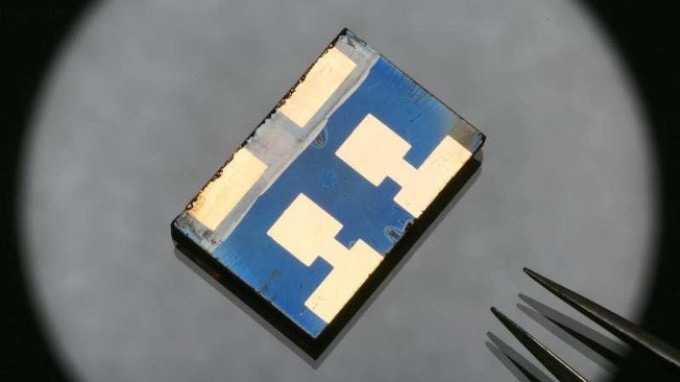Dec 11 2017
A study, carried out by EPFL, reports that adding guanidinium into perovskite solar cells stabilizes their efficiency at 19% for 1000 hours under full-sunlight testing circumstances. Details of the study have been published in Nature Energy.
 Perovskite solar cell prototype. Credit: Alain Herzog / EPFL
Perovskite solar cell prototype. Credit: Alain Herzog / EPFL
With the power-conversion efficiency of silicon solar cells plateauing about 25%, perovskites are at present ideally positioned to become the next generation of photovoltaics in the market. Specifically, organic-inorganic lead halide perovskites provide manufacturing versatility that can potentially mean much higher efficiency: research has already revealed photovoltaic performances over 20% across different solar cell architectures developed with simple and economical processes.
The key challenge for the perovskite field is not really efficiency but stability. In contrast to silicon cells, perovskites are soft crystalline materials and susceptible to problems because of decomposition over time. In a commercial sense, this places perovskites on a higher price tag compared to conventional silicon cells.
There have thus been a number of efforts in synthesizing perovskite materials that can maintain high efficiency over an extended time period. This is realized by adding various cations (positively charged ions) into the crystal structure of the perovskite. Although success has been reported by blending inorganic cations like rubidium or cesium into the perovskite composition, these solutions can be tough and expensive to implement.
In the meantime, no organic – and easier to synthesize – cations that can enhance both efficiency and stability have been discovered thus far. Presently, the lab of Mohammad Khaja Nazeeruddin at EPFL Valais Wallis, with colleagues at the University of Cordoba, has discovered that they can enhance perovskite stability by adding the large organic cation guanidinium (CH6N3+) into methylammonium lead iodide perovskites, which are among the most potential alternatives in the group now.
The researchers demonstrate that the guanidinium cation inserts into the crystal structure of the perovskite and improves the material’s total thermal and environmental stability, overcoming what is referred in the field as the “Goldschmidt tolerance factor limit.” This is a pointer to the stability of a perovskite crystal, which describes how compatible a specific ion is to it. A suitable Goldschmidt tolerance factor should be below or equal to 1; guanidinium’s is only 1.03.
The study discovered that the incorporation of guanidinium greatly enhanced the material stability of the perovskite while providing an average power conversion efficiency more than 19% (19.2 ± 0.4%) and stabilizing this performance for 1000 hours under steady light illumination, which is a regular laboratory test for measuring the efficiency of photovoltaic materials. The researchers approximate that this corresponds to 1333 days (or 3.7 years) of real-world usage – this is based on basic criteria used in the field.
Professor Nazeeruddin explains: “Taking a standard acceleration factor of 2 for each ten degrees increase in temperature, an acceleration factor of 8 is estimated for 55 °C as opposed to 25 °C degrees. Hence the 1000 hours at 55 °C equivalent would be 8000 hours. Our cells were subjected at 60 °C, therefore the numbers could be even higher. Assuming the equivalent of 6 hours full sunlight/day, or 250 Wm-2 average irradiance (equivalent to North Africa) the total number of days are 1333, equals to 44.4 months and 3.7 years stability. However, for the standard solar cell accreditation a series of stress tests including temperature cycling and damp heat are also required.”
This is a fundamental step within the perovskite field. It offers a new paradigm in perovskite design as further explorations beyond the tolerance factor limit could prevail for cationic blends while preserving a 3D structure with improved stability through increased number of H-bonds within the inorganic framework – a problem that we are now close to solving.
Professor Mohammad Khaja Nazeeruddin, EPFL
Contributors
- Universidad de Córdoba
- Humboldt Universitat zu Berlin
- Abengoa Research
- Helmholtz-Zentrum Berlin für Materialien und Energie
Funding
- European Commission Horizon 2020 (SOLEDLIGHT)
- Toyota Motor Europe Technical Center
- Swiss State Secretariat for Education, Research and Innovation (SERI)
- Spanish Ministry of Economy and Competitiveness
- Marie Skłodowska Curie fellowship (Horizon 2020 Grant agreement)
- European Cooperation in Science & Technology (COST)
- Deutsche Forschungsgemeinschaft (DFG)
References
Alexander D. Jodlowski, Cristina Roldán-Carmona, Giulia Grancini, Manuel Salado, Maryline Ralaiarisoa, Shahzada Ahmad, Norbert Koch, Luis Camacho, Gustavo de Miguel, Mohammad Khaja Nazeeruddin. Large guanidinium cation mixed with methylammonium in lead iodide perovskites for 19% efficient solar cells. Nature Energy 08 December 2017. DOI: s41560-017-0054-3